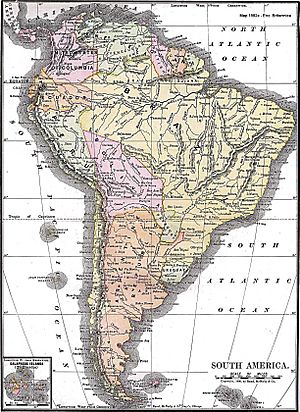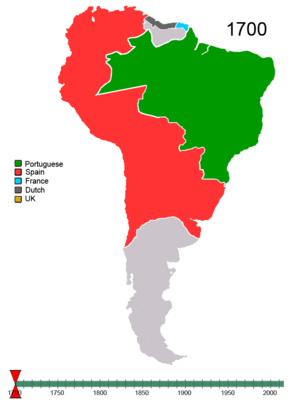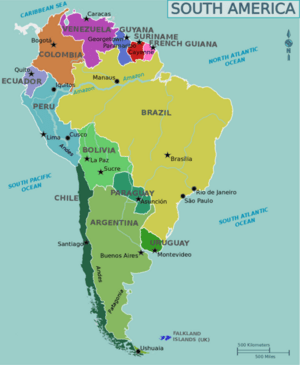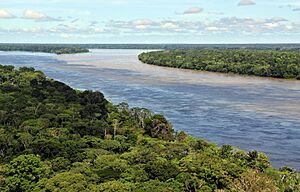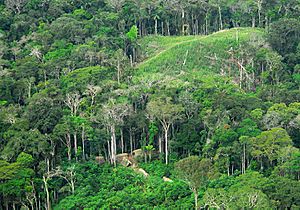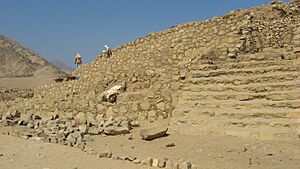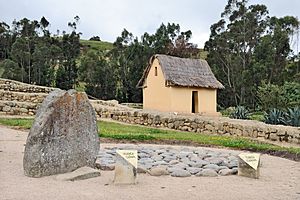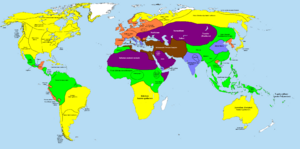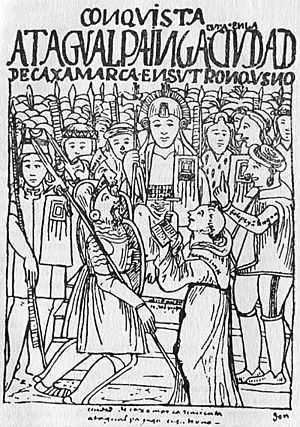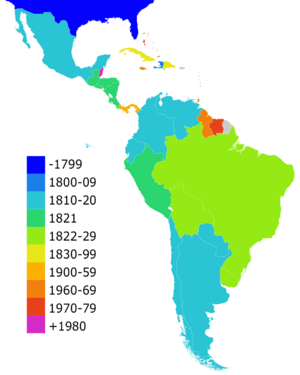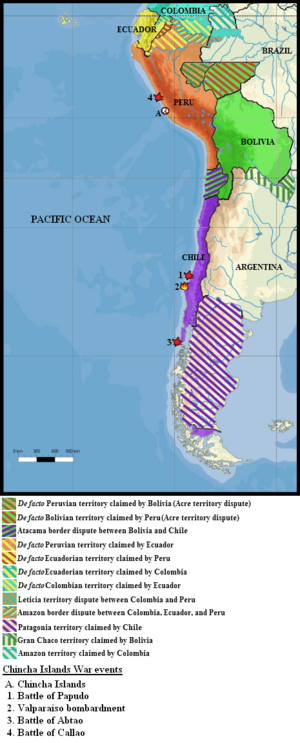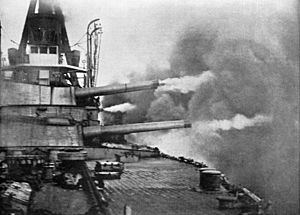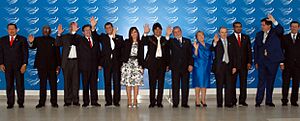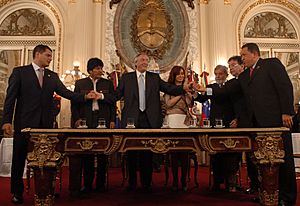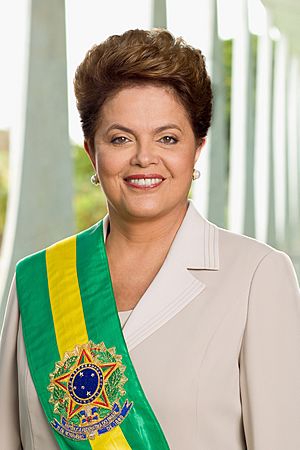History of South America facts for kids
The history of South America explores the past of this huge continent. It looks at written records, spoken stories, and traditions passed down through time. Before Europeans arrived in the late 1400s and early 1500s, many native groups lived here. Some built amazing civilizations.
One of the oldest civilizations in the Americas was the Norte Chico civilization in Peru. It was one of the first six independent civilizations in the world. It existed at the same time as the Egyptian pyramids!
European countries like Spain and Portugal began to colonize South America. This changed the lives of the native peoples forever. Millions of people from Africa were also brought to South America, especially Brazil, through the slave trade. This mixing of different groups created new societies and cultures.
Tensions grew between Europeans, native peoples, and African slaves. This shaped South America from the 1500s onwards. Most Spanish colonies gained independence in the early 1800s after many difficult wars. Brazil became independent from Portugal in a more peaceful way. After independence, South America continued to change. New nations were formed, and many immigrants arrived from Europe. There were also wars over land and power.
Contents
- Ancient South America: Before People Arrived
- Early People: Before Columbus Arrived
- European Colonization: A New Era
- 17th and 18th Centuries: Resistance and Change
- Independence and the 19th Century
- The 20th Century: Wars, Economics, and Politics
- The 21st Century: A Shift to the Left
- Images for kids
- See also
Ancient South America: Before People Arrived
Long, long ago, South America and Africa were joined together in a giant landmass called Gondwana. This was part of an even bigger supercontinent called Pangaea. Around 110 million years ago, South America and Africa started to pull apart.
Later, about 35 million years ago, South America separated from Antarctica. It became a huge island continent, full of amazing plants and animals. For about 30 million years, the plants and animals of South America grew and changed on their own. This led to many unique species.
Around 3 million years ago, South America connected to North America. A land bridge formed where Panama is today. This connection led to the Great American Interchange. Animals from both continents could now move between them. Many North American animals moved south. This caused some South American species to disappear. But some South American animals, like giant sloths and armadillos, also moved north!
Early People: Before Columbus Arrived
Scientists believe the first people in the Americas came from eastern Asia. They crossed a land bridge that once connected Asia to Alaska. Over thousands of years, these groups spread across the Americas.
One of the oldest signs of humans in South America is the Monte Verde II site in Chile. It shows people lived there about 14,500 years ago. Around 13,000 years ago, a special type of spear point called the Fishtail point was used across South America. It disappeared around the same time as many large animals, like mammoths, went extinct.
Farming and Taming Animals
The first signs of farming in South America date back to about 6500 BCE. People in the Amazon Basin started growing potatoes, chilies, and beans. Pottery shows that manioc, a root vegetable still eaten today, was grown as early as 2000 BCE.
In the Andes mountains, people began taming llamas and alpacas around 3500 BCE. These animals were used for carrying things and for meat. Their fur was used to make clothes. Guinea pigs were also raised for food.
By 2000 BCE, many farming villages had grown in the Andes. People along the coast became skilled at fishing. They also built irrigation systems to help water their crops. Important crops included quinoa, corn, peanuts, and squashes. Cotton was also grown for making fabric.
Some of the earliest permanent villages were Huaca Prieta in Peru (4700 BC) and the Valdivia culture in Ecuador (3500 BC). Other groups, like the Muisca in Colombia and the Quechua in Peru, also developed settled farming societies.
Some evidence suggests that people from Polynesia might have sailed to South America long ago. The sweet potato, which came from South America, spread to some Pacific islands. However, there is no genetic proof that people from these two regions mixed.
Norte Chico: An Ancient Civilization
On the coast of Peru, the Norte Chico civilization was one of the first six civilizations to develop on its own in the world. It existed around the same time as the Egyptian pyramids. This civilization was special because it relied on fishing more than farming to feed its people.
The Caral Supe complex is one of the largest Norte Chico sites. It dates back to about 2700 BCE. What's interesting is that there are no signs of warfare at this site.
Cañari: Resisting the Inca
The Cañari people lived in what is now Ecuador when Europeans arrived. They had advanced buildings and religious beliefs. Many of their structures were destroyed by the Inca and later by the Spanish. Their old city, "Guapondelig," was replaced by the Incan city of Tomipamba, and then by the Spanish city of Cuenca. The Spanish thought this city might be El Dorado, the legendary city of gold.
The Cañari bravely fought against the Incan invasion for many years before they were defeated. Many of their descendants still live in the Cañar region today.
Chibchan Nations: People of the Andes
The Chibcha-speaking groups were the largest and most developed cultures in Colombia before the Spanish arrived. They were divided into different groups, including the Tairona and the Muisca.
Muisca: The Salt People
The Muisca were one of the most advanced civilizations in the Americas, along with the Inca in Peru. The Muisca, whose name means "people," lived in the high plains of the Colombian Andes. They formed a loose group of rulers called the Muisca Confederation. When the Spanish arrived, their land covered about 25,000 square kilometers and had between 300,000 and two million people.
The Muisca were known as "The Salt People" because they extracted salt from underground springs. Muisca women did this work, and salt was key to their trading with other groups. They also traded cotton cloths and pottery. Their economy was based on farming, using clever irrigation systems on raised terraces. The Muisca were also famous for their amazing gold-working. Their gold pieces, called tunjos, are now in museums worldwide. They even used coins, which was very rare for pre-Columbian civilizations in South America.
The Muisca's gold and a special gold-silver-copper mix called tumbaga led to the legend of El Dorado, the "land of gold." Spanish explorers, led by Gonzalo Jiménez de Quesada, heard about this wealth. They started a difficult journey into the Andes in 1536. After a year, many soldiers died from the harsh climate and animal attacks. The Muisca leader, Tisquesusa, was defeated by the Spanish in 1537.
Amazon: A Shaped Wilderness
For a long time, people thought the Amazon rainforest was mostly empty, with only a few hunter-gatherer tribes. But recent discoveries show that many people lived there. Since the 1970s, many geoglyphs (large designs on the ground) have been found in deforested areas, dating from 0 to 1250 AD. This suggests that advanced and large cultures once lived in the Amazon.
A BBC documentary, Unnatural Histories, suggested that the Amazon rainforest has been shaped by humans for at least 11,000 years. This was done through practices like "forest gardening."
The first European to travel the entire Amazon River was Francisco de Orellana in 1542. The documentary suggests that Orellana was right when he said a thriving civilization existed along the Amazon in the 1540s. This civilization was likely destroyed by European diseases like smallpox, to which native people had no immunity. Around 5 million people might have lived in the Amazon in 1500. By 1900, the population had dropped to 1 million, and by the 1980s, it was less than 200,000.
Researchers have found fertile terra preta (black earth) in large parts of the Amazon. It is now believed that this soil was created by native people managing the land. This special soil allowed farming and tree growing in an area that was once thought to be difficult for agriculture. Many parts of the Amazon rainforest are likely the result of centuries of human care, not just natural growth.
Andean Civilizations
Chavín: Early Trade and Farming
The Chavín was an early civilization in South America that did not have a written language. They built a trade network and developed farming by 900 BCE. Their artifacts were found at a site called Chavín de Huantar in Peru. The Chavín civilization lasted from 900 to 200 BCE.
Moche: Skilled Artisans
The Moche people lived on the northern coast of Peru between the first and ninth centuries CE. We know about the Moche from their detailed burials.
The Moche were skilled artists and technologically advanced. They traded with distant peoples, like the Maya. Most of what we know about the Moche comes from their ceramic pottery. These pots show scenes from their daily lives.
Inca: Masters of the Andes
The Inca civilization was a powerful empire that ruled the Andes region from 1438 to 1533. Their capital was the great city of Cuzco, shaped like a puma. The Inca empire was called Tawantin suyu, or "the land of the four regions," in their language, Quechua.
The Inca empire included nearly a hundred different language or ethnic groups. It had about 9 to 14 million people. They were connected by a 25,000-kilometer road system. Inca cities were built with incredibly precise stonework, often on mountain slopes. They used terrace farming to grow crops on hillsides. The Inca were also skilled in metalwork and even performed successful skull surgery. They did not have a written language but used quipu, a system of knotted strings, to record information.
Arawak and Carib: Coastal Peoples
The Arawak people lived along the eastern coast of South America, from modern-day Guayana south to Brazil. When Christopher Columbus first met them, he described them as peaceful. However, they were facing increasing pressure from the Carib people. The Carib were fierce warriors who were skilled boat builders and sailors. They were known for their military skills and sometimes practiced cannibalism as part of their war rituals.
Before the Spanish arrived, it's estimated that about a million native people lived in Venezuela and Colombia. Their numbers dropped sharply after the Spanish Conquest. This was mainly due to diseases like smallpox and influenza brought by Europeans. Native people had no immunity to these diseases. Harsh forced labor systems also contributed to the decline.
European Colonization: A New Era
Before Europeans arrived, between 20 and 30 million people lived in South America.
In the late 1400s, the Pope issued special orders that allowed European Christian nations to claim non-Christian lands. These orders encouraged them to take control of and convert people in Africa and the Americas.
In 1494, Portugal and Spain, the two main sea powers, signed the Treaty of Tordesillas. They agreed to divide all newly discovered lands outside Europe between them. An imaginary line was drawn down the Atlantic Ocean. Land to the west of the line would belong to Spain, and land to the east would belong to Portugal. Because they couldn't measure longitude perfectly back then, Portugal ended up expanding its control of Brazil across this line.
In 1498, Christopher Columbus sailed near the Orinoco Delta and landed in what is now Venezuela. Starting in 1499, European conquistadors from Spain and Portugal began to take over South America. They claimed the land and its resources, dividing it into colonies.
European diseases like smallpox, influenza, and measles caused a huge drop in the native population. Native people had no natural protection against these illnesses. Cruel systems of forced labor, especially in mines, also led to many deaths. Some estimates say the population dropped by 20-50%, while others say up to 90%. To replace the lost labor, enslaved Africans were brought in. They had developed some immunity to these diseases.
The Spanish wanted to convert native people to Christianity. They tried to stop any native cultural practices that went against their religion. However, many native groups mixed Catholicism with their traditional beliefs. The Spanish did not force their language as much as their religion. In fact, Catholic missionaries helped spread native languages like Quechua by giving them writing systems.
Over time, native people and Spaniards had children together, creating a mixed-race group called Mestizo. Mestizos and native people often had to pay unfair taxes and were punished harshly for breaking Spanish laws. Many beautiful native artworks, especially those made of gold and silver, were melted down and sent to Europe.
17th and 18th Centuries: Resistance and Change
In 1616, the Dutch, hoping to find the legendary El Dorado, built a fort in Guayana. They set up three colonies there. In 1624, France tried to settle in what is now French Guiana, but the Portuguese forced them out. French settlers returned later and established a settlement at Cayenne in 1643.
From the 1500s, there were protests against the Spanish and Portuguese colonial system. One famous group was the Maroons. These were enslaved people who escaped and formed free communities deep in the forests. Royal armies tried to capture them but failed because the Maroons knew the jungles so well. In 1713, the king officially recognized the first free town on the continent: Palenque de San Basilio in Colombia. Brazil also saw the creation of a large African kingdom called the Quilombo of Palmares.
Other revolts happened, like the Revolt of the Comuneros of Paraguay (1721-1735). This was a conflict between Paraguayan settlers and the Jesuits, who controlled large, successful native communities. In Peru, Juan Santos Atahualpa led an uprising from 1742 to 1756. In 1780, Tupac Amaru II led a major rebellion in Peru, which was continued by Tupac Katari in Bolivia.
In 1763, an African man named Coffy led a revolt in Guyana, but it was brutally stopped by the Dutch. In 1781, the Revolt of the Comuneros (New Granada) in Colombia brought together native people and mestizos. They tried to challenge the colonial power, but their leaders were captured and punished.
In 1796, the British captured the Dutch colony of Essequibo during the French Revolutionary Wars.
During the 1700s, a Spanish priest and scientist named José Celestino Mutis led a major expedition in Colombia. He classified plants and wildlife and founded the first astronomical observatory in Bogotá. In 1801, the famous German scientist Alexander von Humboldt met Mutis. Humboldt also traveled through Venezuela, Mexico, Chile, and Peru. He discovered the cold ocean current off the coast of Peru, which is now named the Humboldt Current after him.
Between 1806 and 1807, British forces tried to invade the Rio de la Plata area (modern-day Argentina and Uruguay). The invasions were stopped, but they weakened Spanish authority.
Independence and the 19th Century
Most Spanish colonies in South America gained their independence in the early 1800s. Leaders like Simón Bolívar (who helped free Colombia, Peru, and Bolivia) and José de San Martín (who helped free Argentina, Chile, and Peru) led these struggles. Bolívar wanted to keep the Spanish-speaking parts of the continent united, but they quickly became separate countries.
Brazil's independence was different. When Napoleon invaded Portugal in 1807, the Portuguese royal family moved their capital to Rio de Janeiro. This made Brazil more important within the Portuguese Empire. In 1822, the Portuguese prince Pedro declared Brazil independent and became its first emperor. This was one of the most peaceful independence movements in history.
After independence, new nations often fought each other for power and land. The Gran Colombia – Peru War and the Cisplatine War (between Brazil and Argentina) ended in stalemates. The Cisplatine War led to Uruguay's independence in 1828.
Later, Chile became a dominant power on the Pacific coast after defeating Spain in the Chincha Islands War and Peru in the War of the Pacific (1879–1883). On the Atlantic side, Paraguay tried to gain more power but was defeated by an alliance of Argentina, Brazil, and Uruguay in the War of the Triple Alliance (1864–1870). By the 20th century, Argentina, Brazil, and Chile were the main powers in South America.
A few countries did not gain independence until the 20th century:
- Panama, from Colombia, in 1903
- Trinidad and Tobago, from the United Kingdom, in 1962
- Guyana, from the United Kingdom, in 1966
- Suriname, from the Netherlands, in 1975
French Guiana is still a part of France today.
The 20th Century: Wars, Economics, and Politics
Early 1900s
At the start of the 20th century, the United States became more involved in South American affairs. This was to protect its own interests. The "Big Stick Doctrine" stated that the U.S. would intervene to prevent European influence.
1930s to 1960s: Economic Changes and World War II
The Great Depression in the 1930s hit South America hard. The demand for raw materials dropped, hurting many economies. South American leaders decided to focus on "import substitution industrialization." This meant making goods themselves instead of buying them from other countries. The goal was to create stronger economies with their own industries and a larger middle class.
During World War II, the United States and most Latin American nations worked together. The U.S. needed raw materials for the war effort. Countries like Colombia provided platinum, Chile provided silver, and Peru provided cotton, gold, and copper. Brazil was very important strategically because it was the closest point in the Americas to Africa, where the Allies were fighting the Germans. Brazil was the only South American country to send soldiers to fight in Europe.
Cold War: A Divided Continent
Wars between South American countries became less common in the 20th century. The Chaco War (Bolivia-Paraguay) and the Ecuadorian–Peruvian War were among the last.
In the late 20th century, South America became a battleground for the Cold War. This was a global struggle between the United States and the Soviet Union. Many democratically elected governments in Argentina, Brazil, Chile, Uruguay, and Paraguay were replaced by military dictatorships in the 1960s and 1970s. These dictatorships were often supported by the United States.
To stop opposition, these governments arrested thousands of political prisoners. Many were tortured or killed. These countries also started to adopt new economic policies. By the early 1990s, however, all these countries had returned to democratic rule.
The 21st Century: A Shift to the Left
In the early 2000s, many South American governments moved to the political left. Leaders who favored more government control and social programs were elected in countries like Venezuela, Brazil, Argentina, Bolivia, and Ecuador. This trend is sometimes called the "pink tide."
These leaders often broke away from the "Washington Consensus." This was a set of economic ideas promoted by the U.S. that favored open markets and privatization. The "pink tide" leaders often preferred policies that helped local industries and reduced foreign influence.
Pink Tide Leaders
The "pink tide" refers to the idea that left-leaning politics became more popular in Latin America in the 21st century.
Since the 1990s and 2000s, many left-wing politicians have come to power. These include:
- Hugo Chávez in Venezuela (1998)
- Ricardo Lagos (1999) and Michelle Bachelet (2006, 2014) in Chile
- Luiz Inácio Lula da Silva (2002) and Dilma Rousseff (2010) in Brazil
- Néstor Kirchner (2003) and Cristina Fernández de Kirchner (2007, 2019) in Argentina
- Tabaré Vázquez (2004, 2015) and José Mujica (2010) in Uruguay
- Evo Morales in Bolivia (2005)
- Rafael Correa in Ecuador (2006)
- Fernando Lugo in Paraguay (2008)
- Ollanta Humala in Peru (2011)
- Nicolás Maduro in Venezuela (2013)
- Luis Arce in Bolivia (2020)
- Pedro Castillo in Peru (2021)
- Gabriel Boric Font in Chile (2022)
- Gustavo Petro in Colombia (2022)
Politics and Regional Unity
In the first decade of the 21st century, South American governments generally moved to the political left. Many countries started using more protectionist policies. This helped local development but sometimes made it harder to integrate with the global economy.
In 2008, the Union of South American Nations (USAN) was created. Its goal was to combine existing trade groups like Mercosur and the Andean Community. This would form one of the largest trade blocs in the world. USAN also aims for political unity, like the European Union. It seeks to allow free movement of people, promote economic growth, and create a common defense policy. Some experts believe USAN represents a new era where Latin America is working together more closely than ever before.
Images for kids
See also
 In Spanish: Historia de Sudamérica para niños
In Spanish: Historia de Sudamérica para niños
- Inca Empire
- Gran Colombia
- History of Latin America
- Military history of South America
- Peru–Bolivian Confederation
- Simón Bolívar
- José de San Martín
- Francisco Pizarro


